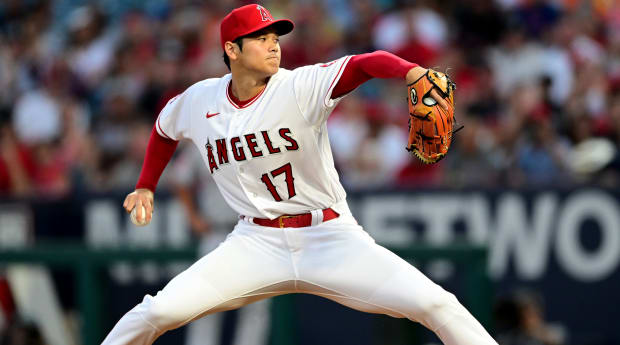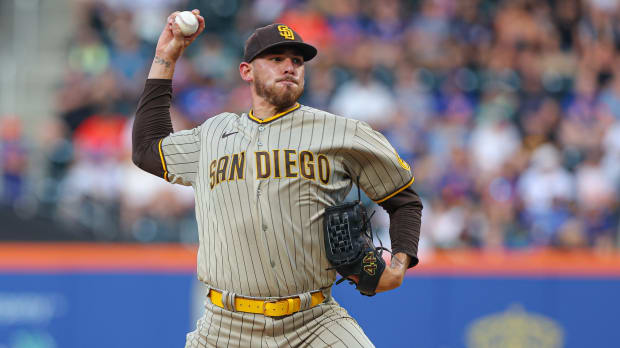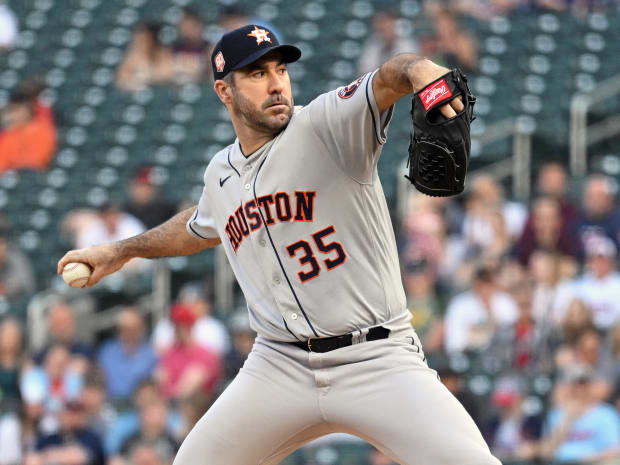The Astros, Padres and Angels are prime examples of what star pitchers can produce on five days’ rest.
In 1925, the use of five-man rotations surpassed the four-man method for the first time. It took longer than that for them to fully catch on, though, and it’d be disingenuous to suggest it’s been almost a century since the blueprint for starter usage was tinkered with—it’s a particular kind of baseball science, with change coming in waves.
Many teams reverted to using four starters by the 1950s, at which point lights had been installed at every stadium (except for Wrigley Field), allowing doubleheaders to be largely cut from the schedule and thus giving teams more time to rest their best arms. Gil Hodges’s ’69 World Series–winning Mets are often credited with popularizing the five-man cycle—or at least giving each pitcher four days’ rest. The Dodgers of the early ’70s are also regarded as early five-man pioneers: They had reason to be after witnessing Sandy Koufax’s premature injury-forced retirement in ’66 following mostly throwing on three days’ rest (and occasionally two when the situation called for it, as it did in Game 7 of the ’65 World Series). The vast majority of teams followed suit by the ’80s.
Regardless of the exact timing, it’s fair to say that employing five starting pitchers has long been the norm in the majors. Could the next evolution in a sport be expanding that number to six? A few teams have made a strong argument for it this season.
The Angels have done it for several years due to Shohei Ohtani’s presence. The two-way superstar migrated in 2018 from the KBO, where pitchers take the mound only once per week. Wanting to protect him, Los Angeles adopted a six-man rotation in ’18 and have largely kept it up ever since, even when Ohtani didn’t pitch between ’19–’20 due to Tommy John surgery. The Angels have produced their best results from the experiment this summer. Their rotation ranks 10th in the majors in FanGraphs’ version of WAR (9.4), 11th in ERA (3.80) and 11th in win probability added (1.7). Those numbers may not seem revelatory, but they’re certainly an improvement on previous years in the Mike Trout era, when the Halos have by and large failed to construct playoff-caliber pitching staffs. Last season, for example, their starters ranked 16th in fWAR, 22nd in ERA and 23rd in WPA.

Jayne Kamin-Oncea/USA TODAY Sports
The Padres, meanwhile, utilized the strategy this year to take advantage of their stacked stable of starters. They converted to a six-man rotation upon the return of Mike Clevinger from a long recovery from Tommy John surgery and stuck with it through most of the summer. But after the Padres traded away rookie MacKenzie Gore and his respective innings limit in the Juan Soto blockbuster two weeks ago, they had less incentive to continue what’d been a successful endeavor and decided not to stretch out Nick Martinez again (after he’d already been shuttled from the rotation to the bullpen once this season and adjusted well). Nevertheless, it has to go down as a rousing success while it lasted. One year after San Diego’s bullpen pitched the second-most innings in MLB to make up for an injury-depleted rotation that ranked 18th with a 4.54 ERA, its starters have flipped the script and rank second in innings (667), third in K/9 (9.2), seventh in fWAR (10.5) and 10th in ERA (3.78).
Other teams have temporarily rotated through six starters when the schedule gets compact due to a long stretch of games without an off day or several doubleheaders, or perhaps early on when pitchers are still building up their stamina.
None have executed the strategy as consistently and as well as the 2022 Astros, though. Houston had every reason to commit to the new-age way, as Justin Verlander was somewhat similar to Ohtani as a veteran returning from Tommy John surgery whom his team wanted to protect. And like the Padres, the reigning American League champions had enough quality starters to render the six-man an advantage rather than a necessity. Even after trading veteran hurler Jake Odorizzi to Atlanta at the deadline, Lance McCullers Jr. slid into the vacated slot this week after his recovery from Tommy John surgery was complete. The results speak for themselves. Houston leads all teams in rotation fWAR (12.9) and innings (684 ⅓), ranks second in ERA (3.10) and fourth in WPA (6.2).
“I think, by and large, the guys would say that it’s benefited them and allowed them to be their best pitcher more often,” Astros pitching coach Josh Miller says. “We’ve pitched very well this year, partly due to the six-man rotation and how the guys have been fresh more consistently, and I think that’s done good things for us.”
The benefits for any team looking to make the switch can be enticing. Obviously, each starter gets an extra day of rest. That’s ideal for any players who are on innings limits, whether due to youth or health. It also enables managers to push their most trusted guys a little further in the games they do pitch, a mitigating force against the trend of starters being pulled earlier than ever.
San Diego and Houston have both made use of that edge, with each of those clubs’ two workhorses—Yu Darvish and Joe Musgrove for the Padres, Verlander and Framber Valdez for the Astros—pitching deeper into games than just about everyone this side of Marlins ace Sandy Alcántara.

Vincent Carchietta/USA TODAY Sports
Of the 86 pitchers with at least 100 innings, Verlander, Valdez, Darvish and Musgrove rank fourth, fifth, seventh and eighth, respectively, in innings pitched per start. And while their raw inning totals are not in the top tier—Verlander is tied for eighth in innings, while Valdez is tied for 11th and Darvish comes in at 14th—that trio owns the three highest inning totals for starters with 22 starts, while Musgrove has the most among pitchers with 21 starts.
Watch MLB games live with fuboTV: Start a free trial today!
Darvish has topped 100 pitches 13 times and in 11 of his past 12 starts. That’s something he did just five times last season and in 2020. You’d have to go back to ’18 to find the last year he had thirteen 100-pitch innings, and that was the only other time he’s done it since having Tommy John surgery in ’15. His performance this year has likely been helped by making 18 of his 22 starts after at least five days of rest.
Musgrove has a career-high seven 100-pitch outings after having six in 2021 (only three of which had happened at this point in the season). He’s made 16 of 21 starts with five-plus days’ rest.
Valdez has nine 100-pitch outings this year, three more than his career high, after receiving at least five days’ rest before 18 of his 22 starts.

Nick Wosika/USA TODAY Sports
Verlander isn’t throwing as many pitches as he did before his elbow injury, but his arm clearly isn’t suffering from fatigue, either: He’s enjoyed perhaps his finest campaign this season at age 39. The two-time Cy Young winner has allowed zero runs or one run in 15 of 22 starts. Heading into Tuesday night, he was the first player in MLB history to lead the league in wins and ERA at age 39 or older, per MLB Network. He ended up relinquishing the MLB ERA lead to Alcántara by the end of the night, but Verlander still leads the league in WHIP for good measure. All that could be partially due to the extra rest he’s received to this point, as he’s also had at least five days’ rest in 18 of 22 starts this year.
That’s not to say it isn’t an adjustment for starters, who are creatures of habit and generally have a stronger opinion about keeping their routine the longer they’ve had success with it.
“Some guys operate better on a five-day schedule. That’s what they’re used to. You know, we have a couple of veteran pitchers here,” Miller says, before listing off Verlander, McCullers and the recently traded Odorizzi. “They’re used to the five-day schedule, the bullpen [session] on Day 2, and they have their routine. Disrupting that is challenging at times.”
Adding a pitcher to the rotation also removes one from the bullpen, which leaves the relief corps more prone to overuse if a few starters in a row get rung up.
“The starters have to cover [innings]. They have to pitch well,” Miller says. “And largely this year we’ve done that, which has made it a lot easier on [Astros manager] Dusty [Baker] and our staff to navigate it.”
If Houston does end up inspiring others to spread out their starters, it wouldn’t be because of a concerted effort to break ground or push the six-man agenda. It’s simply about what’s long been one of MLB’s most creative baseball operations departments adjusting to its roster.
“It’s something that we didn’t aim to do,” Miller says. “It was just like, ‘Hey, how are we going to best use the guys on our roster now?’ And we felt like starting them [on five days’ rest] was the better option.”
It’s proven to be the right call so far. The six-man rotation may not be for every team, especially those who struggle to fill out a five-man outfit, let alone a six-pack. But for those who can, it could be worth a shot—and speaks well to where the game could be going.
More MLB Coverage:
• MLB Power Rankings: Guardians Shake Up the Top 10
• Fernando Tatis Jr.’s Steroid Suspension Costs the Padres Their Dream Season
• The ‘Field of Dreams’ Game Deserves to Be an MLB Tradition
• The White Sox Are Suffering the Consequences of Doing Nothing
• Is Nationals Starter Patrick Corbin Having the Worst Pitching Season Ever?